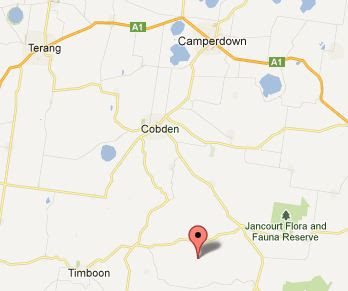 |
| Wheel plough, Fife Folk Museum. (Image copyright Kim Traynor) |
James and William Alford were brothers and they migrated together in February 1855 from Devonshire in England to South Australia. They were agricultural labourers in Devon and must have learned how to plough properly because both of them were very successful in ploughing competitions in South Australia and Victoria.
In the newspapers at Trove I've found quite a few articles detailing their successes and also those of William's sons, Thomas and George. Here's a taste.
James was living near Encounter Bay in South Australia when he entered this ploughing competition with a horse-drawn wheeled plough (similar to above) and took out first prize.
...
...
 |
South Australian
Register, 4 August 1855, p.3
|
 |
| Photo taken from Rosetta Head (the Bluff) west of Victor Harbor, showing the vicinity of the ploughing match. |
The Fountain Inn mentioned above still exists. It's now a B&B called 'Yelki by the Sea'. James left South Australia and moved to Victoria. He also appears to have left farming and I can't find any other references to him as a ploughman. But his brother William was a farmer in Victoria and entered quite a few ploughing matches (Bendigo, Baringhup, Marong, Warragul, Buln Buln) as a competitor and was later a judge. Ploughing matches were very popular events in the 1800s.
 |
| Ploughing Competition. Powerhouse Museum collection (on Flickr) |
 |
| Bendigo Advertiser, 25 June 1869 |
The Lennon plough used by Alford was made by Hugh Lennon's company in Melbourne. His single and double furrow ploughs were hugely popular and William Alford seems to have also liked them very much. [Ned Kelly also used one of his ploughs to make his
metal armour.]
William ALFORD, son
of Jacob ALFORD and Mary WEBBER was born in 1827 in George Nympton,
Devon, England. He died on 15 Jul 1903 in Warragul, Victoria, Australia. He
married Ann ROGERS, daughter of Philip ROGERS and Mary ? on 21 Mar 1851
in George Nympton, Devon, England. She was born in 1828 in Meshaw,
Devon, England. She died on 05 Feb 1906 in Warragul, Victoria, Australia (At
the home of George Henry Alford.).
James
ALFORD, son of Jacob ALFORD and Mary WEBBER was born on 27 Jan
1832 in Devon, England. He died on 08 Sep 1895 in Ballan, Victoria,
Australia. He married Honora FALLON, daughter of Owen FALLON and ? on 26
Oct 1855 in Encounter Bay, South Australia, Australia. She was born in 1833 in
Sligo, Ireland. She died on 27 Feb 1880 in Parwan, Victoria, Australia. He
married Elizabeth KELL, daughter of John KELL and Elizabeth AGNEW in
1882 in Victoria, Australia. She was born about 1845 in Ireland. She died on 29
Sep 1939 in Ballan, Victoria, Australia.




































